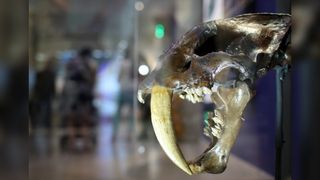
Did cats really disappear from North America for 7 million years?
Were they looking for balls of yarn?

Domestic cats sometimes disappear for days at a time before, generally speaking, turning up safe and sound. But this relatively short vanishing act is nothing compared with the "cat gap" — a period in the fossil record from approximately 25 million to 18.5 million years ago when cats and cat-like species seem to have "disappeared" from North America for almost 7 million years.
So, what is the reason for this gap? Is it just another example of the baffling behavior of cats, such as their penchant for sitting in boxes or running around in random bursts of speed without the slightest provocation? Did they grow tired of North America? Could it all be a misunderstanding?
Various theories have been suggested, ranging from cats and cat-like species moving away from North America to find better hunting grounds, to them being impacted by global cooling from volcanic eruptions (which have caused other mass extinction events in different time periods) to conditions at the time not being suitable for fossilization.
But, according to Carlo Meloro, a vertebrate palaeontologist at the Liverpool John Moores University in the U.K., only so much can be concluded based on current knowledge and evidence. As for those ideas, they shouldn't be considered as anything other than guesswork, according to Meloro.
Related: Why do cats wiggle their butts before they pounce?
"It is all conjecture," he said. "If specific geological activities prevented cats from being found in North America in sediments during this period, it does not necessarily mean they weren't there." Meloro highlighted that "a combination of factors might have generated the cat gap," which could conceivably include "climate change, competition with other species and ecological displacement."
David Polly, a paleontologist at Indiana University Bloomington, agreed. "The absence of cats cannot be explained by [the] absence of the fossil record," he said. However, Polly believes there may be a more obvious explanation, and it is one supported by Meloro.
Sign up for the Live Science daily newsletter now
Get the world’s most fascinating discoveries delivered straight to your inbox.
"The exclusion of cats from North America is, at some level, simply a coincidence involving the extinction of one cat-like group and the inability of another to get into North America," Polly told Live Science. In other words, the "gap" might be real.
Mind the gap
Before the cat gap, Meloro explained, three taxonomic families of cats existed: Nimravidae, Barbourofelidae and Felidae, all belonging to the taxonomic order Carnivora.
Nimravidae, commonly known as "false saber-toothed cats," and the cat-like carnivores Barbourofelidae, both of which are now extinct, had similar features to modern domestic cats. Though biologically similar, they are not directly related to today's cats. Felidae, on the other hand, are.
"A true cat," Polly said, "is one that is closely related or ancestral to living felids, which include cats, lions, tigers and servals."
These three taxonomic groups, though similar in appearance and genetic makeup, did not all live in the same regions at the same time. This point, according to both Meloro and Polly, is crucial to understanding the cat gap.
"In North America, Nimravidae can be found during the Oligocene and up to 28.7 million years ago, so they appear to have disappeared just before the cat gap," Meloro said. "Barbourofelidae, meanwhile, arrived in North America after the cat gap, with members of the genus Barbourofelis appearing between 11.5 [million] and 9.8 million years ago."

The demise of nimravids, according to Polly, "defines the start of the cat gap." It is likely, he continued, that the species' extinction was a result of the North American ecosystem changing in such a way that it became "difficult to function as a hypercarnivore." Polly added that, during this time, herbivores — the probable prey of nimravids — evolved "specializations for faster locomotion covering large distances," which would have made it much harder for a hypercarnivore to hunt food consistently.
So, according to Meloro, one "cat-like" species was already extinct at the time of the cat gap, and another had yet to make the move to North America. But what of Felidae, the true relatives of today's cats?
"Immigration of felids to North America required a land connection to Eurasia and ecosystems in which cats could thrive," Polly said. "The sea level bobbed up and down in the Miocene [23.03 million to 5.3 million years ago], and cats likely crossed into North America then, probably across Siberia to Alaska.
"The availability and viability of the land bridge would have required both low sea level and appropriate ecosystems in the land bridge area," Meloro added. This is also likely how Barbourofelidae came to reside in North America.
Therefore, very few fossils of cats or cat-like species have been discovered in North America during the "cat gap" period, Polly believes, because there simply aren't any to be found.
Related: Why can't house cats roar?
But, even if there are cat fossils in North America from the "cat gap" period ready and waiting to be uncovered, there is no guarantee they would be found in great numbers, according to another expert.
David Martill, a paleontologist from the University of Portsmouth in the U.K., has suggested that the lack of Felidae fossils from this period could conceivably be a result of very few people attempting to seek them out. "How many people go out hunting for fossils of cats?" he said.
Martill also pointed out that such fossil gaps are common. "The fossil record is extremely patchy," he said. "The stratigraphic [rock layer] record is full of time gaps. Indeed, there are more gaps than there are records."
Polly conceded that a lack of fossil hunters could, in theory, explain the cat gap.
"The fossil record does not uniformly sample all of North America, so it is possible that nimravids persisted later than 23 million years in some corners of the continent, or that felids arrived in some areas before 17 million years ago," he said.
However, he is not entirely convinced.
"The fossil record of mammals, including carnivores, is very good in North America during the cat gap," Polly said. "We have hundreds to thousands of fossil sites during that interval, with tens of thousands to perhaps millions of fossils."
Originally published on Live Science.

Joe Phelan is a journalist based in London. His work has appeared in VICE, National Geographic, World Soccer and The Blizzard, and has been a guest on Times Radio. He is drawn to the weird, wonderful and under examined, as well as anything related to life in the Arctic Circle. He holds a bachelor's degree in journalism from the University of Chester.
